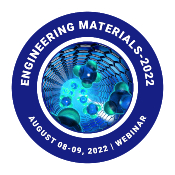About Conference
Welcome to the Materials Science and Engineering (Hybrid Conference) and also join the conference using online platforms during August 08-09, 2022 Budapest, Hungary. Engineering Materials-2022 is being organized with the association of Journal of global journal of engineering design and technology where all the conference abstracts will be published.
Global Journal of Engineering Design and Technology (GJEDT):Design strategies, Usability and adaptability, Material, component, and system performance, Process control, Sustainability criteria, indicators, measurement and processes, Risk management, Computational Statistics, Computer sciences, Business Ethics, Industrial applications of neural networks, Information and data security, Information indexing and retrieval, Infrastructure investment layout, Infrastructural design,
The theme of the conference highlights “Novel techniques in the field of Materials Science and Engineering”. Attendees and participants will be able to learn extremes thanks to scientific tracks created for this conference.
Importance & Scope:
Materials Science and Engineering have not only aided in the advancement of several sectors of science and technology, but have also made significant contributions to the betterment of human life quality. All of this is feasible because to another round of discoveries and inventions that have evolved in several new applications. The main goal of the Engineering Materials conference is to allow participants to network, communicate, and exchange new ideas in the domains of materials science and engineering.
Why to attend Engineering Materials 2022?
Engineering Materials 2022 provides a platform for globalizing research by facilitating dialogue between companies and academic institutions, as well as information transmission from research to industry. Engineering Materials 2022 intends to disseminate knowledge and new ideas among experts, industrialists, and students working in the fields of materials science and engineering by allowing them to share their research experiences and participate in interactive discussions and special sessions.
Target Audience:
Sessions and Tracks
Track 01: MATERIALS SCIENCE AND ENGINEERING
Materials Science and Engineering: Physical Science focuses on the relationship between the structure of an atom and the molecule of matter, the properties of things (such as energy, electrical or material), and the way materials are produced or processed into shape or product. The Center for Electron Microscopy and Analysis is at the heart of this effort. CEMAS is the world's leading industry and educational tool. Engineering is the use of science and mathematics to solve problems. Although scientists and designers have come up with incredible ideas, engineers have applied these inventions to the real world. Welding Engineering is a complex engineering field that requires a thorough understanding of many areas of engineering. Welding Engineer students begin their welding engineering education after successfully completing their first required engineering courses. Materials science is an interdisciplinary field concerned with the understanding and application of the properties of matter.
Track 02: Nanotechnology in materials science
Nanotechnology: Nanotechnology, also shortened to nanotech, is the use of a substance on atomic, molecular and supra molecular scales for industrial purposes. The earliest, most comprehensive description of nanotechnology refers to the specific technological goal of manipulating molecules and atoms for the manufacture of macro scale products, now also known as molecular nanotechnology. A more general description of nanotechnology was then established by the National Nanotechnology Initiative, which defined nanotechnology as the movement of matter with at least one dimension from 1 to 100 nanometres. This definition reflects the fact that quantum mechanical effects are important on this quantum-real scale, and so the definition has shifted from a specific technical goal to a research category that includes all types of research and techniques that deal with the special properties of matter. Below the given size threshold. The plural form "Nano technologies" as well as "Nano scale technologies" are therefore common to refer to a wide range of research and application which has a common characteristic size.
Track 03: Batteries and energy materials
Batteries materials: An electric battery is a source of electrical energy consisting of one or more electrochemical cells that have an external connection to power objects. The terminal marked as negative is the source of electrons that will flow from the external electrical circuit to the positive circuit. On the other hand, lithium-ion batteries are pushed to their limits due to the continued need for improved performance, overall safety, and lower cost.
Energy materials: Energy materials are used to describe anything that can react to a power outlet. Energy objects are a class of substances with a high amount of stored chemical energy that can be released. Energy objects include a wide range of substances that may be effective in converting energy or transmission.
However, there were two major problems with this cell that prevented it from being sold at that time:
Track 04: Mining, Metallurgy and Materials Science
Mining: Mining engineering involves the extraction of resources from the earth and the refining of raw industrial materials. These mostly include Geology, Mechanical Engineering and Chemical Engineering etc.
Materials science is "further down the supply chain" involved in the application of many mining resources for specific research and development. Some of these products may involve application but often engineers (especially mechanical and chemical engineers) do it more often, helping them decide which material to use, depending on the work of the material scientists.
Metallurgy is a domain of materials science and engineering that studies the physical and chemical behaviour of metallic elements, their inter-metallic compounds, and their mixtures, which are known as alloys. Metallurgy encompasses both the science and the technology of metals; that is, the way in which science is applied to the production of metals, and the engineering of metal components used in products for both consumers and manufacturers. Metalworking relies on metallurgy in a similar manner to how medicine relies on medical science for technical advancement.
Materials Science: The field of architectural science, also called architecture and engineering, involves the design and discovery of new materials, especially solid materials. The origin of scientific discovery dates back to the Enlightenment, when researchers began to use analytical reasoning from chemistry, physics, and engineering to comprehend ancient, phenomenological observations in metallurgy and mineralogy.
Track 05: Emerging technologies in materials science
Emerging technologies in materials science: Emerging technology is a term commonly used to describe new technology, but it can also refer to the continuous development of existing technology; it may have a slightly different meaning when used in different fields such as media, business, science or education. Consequently, the current chapter should serve as a mild reminder of the information most readers already have, a direct introduction to newcomers to the discipline, and as a means of connecting this well-known knowledge with sustainability issues. The languages we use to communicate certainly include metals and content, whether in informal or formal settings. Exploring the origins of words like metal, material, iron and steel can reveal a lot about how different cultures have formed current concepts that these words now suggest. Dictionaries and encyclopaedias offer the first definitions that scientists and professionals share with people before they move on to their special skills. Metals are the most abundant chemical element on the planet. The Mendeleev language table of chemistry proposes a universal description of metals, which contradicts the assumptions of metallurgists and physicists. The word is the same, but the concepts are different! Buildings, infrastructure, transportation, equipment, industrial facilities and other human artefacts are made of materials, a unique form of matter.
Track 06: Biomaterials and Tissue Engineering
Biomaterials focus on the development of materials that improve the interface between technology and human tissues. For example, controlling neural responses to materials could aid in allowing effective recovery from spinal cord injuries. Biomaterials are a science that's been around for about fifty years. Biomaterial science or biomaterial engineering is the study of biomaterials. Throughout its history, it has witnessed steady and strong expansion, with many corporations investing large quantities of money in the development of new products. Medicine, biology, chemistry, tissue engineering, and materials science all play a role in biomaterial science.
Tissue engineering is a biomedical engineering discipline that restores, maintains, repairs, or replaces a range of biological tissues using a combination of cells, engineering, material technologies, and appropriate biochemical and physicochemical variables. The placement of cells placed on a tissue scaffold to build new tissue is common in tissue engineering.
Track 07: Structural Materials and Characterization
Structural Materials and Characteristics: when used in materials science, it refers to the broad and general process by which the composition and properties of materials are examined and measured. It is a fundamental process in the field of materials science, without which no scientific understanding of engineering materials can be determined. The scope of the word is often different; some definitions limit the use of the term to techniques that study the microscopic structure and properties of materials, while others use the term to refer to any material analysis process, including macroscopic techniques such as mechanical testing, thermal analysis, and density calculation. The scales of structures observed in the characterization of materials range from angstroms to centimetres in imaging of individual molecules and chemical bonds, as in the imaging of coarse grain formations in metals. This article examines recent developments in charge storage processes, electrode materials, electrolyte materials, systems, characterization methods and applications for super capacitors. In contrast, the recently established charge storage method for intercatalytic pseudo capacity behaviour, which bridges the gap between battery and conventional pseudo capacity behaviour, is also discussed. Finally, the advantages and disadvantages of using super capacitors in real-world applications are examined.
Track 08: Polymer Science and Technology
Polymer Science and Technology: Polymer Science or Macromolecular Science is a subdivision of polymer related materials science, mainly synthetic polymers such as plastics and elastomers. The field of polymer sciences includes researchers in multiple disciplines, including chemistry, physics, and engineering. The global industry for controlled-release polymer systems, which involves more than just drug delivery, is currently valued at $ 60 billion annually, with more than 100 million individuals using its products each year. Polymers used in bio-textiles should have three special qualities. The first is that they can be spun. For fibre production, this is the most crucial property. Their flexibility is another feature. This is important when a change in the form and / or parameters of the DDS is required during its application. Their biological compatibility is the ultimate feature. This is important for the preparation of oral DDS, implantable DDS and other types of DDS. Since TDDS fibers are made up of various filament forming polymers and natural fibres, they use X vivo. Various other considerations must be made, such as how the polymer affects drug characteristics, drug delivery routes, and desirable drug withdrawal modalities.
Track 09 Mechanics and Materials Science
Mechanics and Materials Science includes computational, analytical and experimental solid mechanics, mechanical behaviour and engineering of materials and materials science. Mechanics of water purification and temperature sensitive biochemical reactions, dynamics of precision surface tracking in rigid 3D terrain, effect of post-fabrication surface treatment on permeability and corrosion resistance of reinforced concrete; Responsive and constructive modelling of emerging content. Polymers are included in chemistry and chemical engineering classes. Solid state physics was a well-known field of physics at that time. Electronic content was already attracting a lot of attention, and some departments were teaching specific subjects. Many other properties of the material including mechanical properties, corrosion resistance and material processing were also affected. Apart from civil engineering, important materials like wood and concrete were largely neglected. Research, as it should be, frequently studies the fields of anisotropic plastic reactions of metals and constructive modelling of observed responses, often ignoring the differences between grain-size reduction using reduced plastic deformation and reduced grain-size metals investigation; Modelling and design of biomedical devices, surface modifications and wear of artificial joints, structure / function relationships in aging and diseased human tissues; Biomaterials Micro scale sample testing, carbon nanotube infused multi-length scale composite and friction stir welding fracture and fatigue.
Track 10 Materials Chemistry and Physics
Materials science focuses on materials at every level–in addition to the materials the chemists work on, materials scientists may work on metals, semiconductors, and ceramics. Materials science also focuses on understanding the structure of materials, while chemistry focuses more on chemical reactions. Material chemistry involves the use of chemistry for the formation and synthesis of materials with interesting or potentially useful physical properties, such as magnetic, optical, structural or catalytic properties. The intellectual origins of materials science date back to the age of knowledge, when researchers began to use analytical thinking from chemistry, physics, and engineering to understand ancient, extraordinary observations in metallurgy and mineralogy. Materials science still includes components of physics, chemistry, and engineering.
Material physics is the use of physics to describe the physical properties of materials. It is a synthesis of physics such as chemistry, solid mechanics, solid state physics and materials science. Materials Physics is considered a subset of condensed matter physics and applies the basic condensed matter concept to complex multiphase media, including materials of technological interest. Current areas in which physicists work include electronic, optical and magnetic materials, novel materials and structures, quantum phenomena in materials, no equilibrium physics, and soft condensed matter physics. New experimental and computational tools are constantly improving how material systems are modelled and studied and there are areas where physicists work.
Track 11: Computational Materials Science
Computational materials use modelling, simulation, theory and informatics to understand science and engineering materials. These computer simulation methods use underlying models and estimates to understand physical behaviour in more complex situations than pure theory usually allows, and with more detail and precision than is often possible from experiments. Each method can be used independently to predict the properties and mechanisms of the material, to inform other simulation methods running separately or simultaneously, or to directly compare or contrast with the experimental results.
A significant sub-field of computational materials science is integrated computational materials engineering, which seeks to use computational results and methods in conjunction with experiments, focusing on industrial and commercial application. Key current themes in the field include new approaches due to data infrastructure, high-throughput content design and discovery, and a significant increase in computing power and a consistent history of supercomputing, to promote uncertainty and final decision-making across simulation, sharing simulation inputs and results.
Track 12: Materials Engineer Training and Career
Materials engineer training and career: Materials science deals with structural analysis of materials, discovery of new physical materials and their application in various industries. The field of materials engineering looks at the relationship between the properties of materials and their mechanical composition at the atomic level. Material engineers strive to create new materials that meet specific chemical, electrical, and mechanical requirements. Plastics, ceramics, metals, semiconductors and composites can be used to do this. Material engineers often come up with new applications for older materials. Material engineers work with the molecular structure of the material. They simulate and evaluate the characteristics of various materials and their components using sophisticated computer software. Their work is vast in scope, and material engineering applications can be found in a variety of technical domains. Ceramic engineers deal with ceramic materials and create techniques that can be used in the production of a wide range of ceramics materials.















